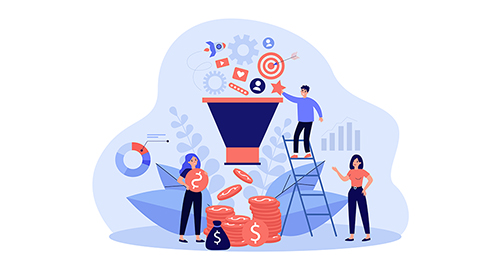Tips for Creating Your First Email Marketing Strategy
Email marketing has been one of the most enduring, effective marketing mediums of the past 20 years. Brands effectively use this communication method to nourish relationships with leads, share important information with customers, and turn one-time buyers into loyal, retained customers. This versatile marketing approach works for both service and product-based businesses. The key to success is implementing a purpose-driven email marketing strategy. Don’t let analysis paralysis stop you from getting started. Use these effective tips for creating your first email marketing strategy and adjust your approach.
Email Marketing Strategy Step 1 – Define Your Goals
The first step in creating any marketing strategy is to define your goals. For email marketing, in particular, this means reconnecting with your target audience and determining what solutions you can offer for their perceived problems. Set targeted goals about how often you want to send communications, who you’ll target, and what information you’ll cover. You’ll also need to consider how you’ll attract subscribers to your list and how you’ll highlight the value of joining. You should also define your audience and niche down to help create better targeting with your efforts.
While you can create list-size goals, it’s better to have action-oriented intentions to get you there. For example, rather than focusing on the goal of having 100 subscribers within the first month, consider focusing on consistency and engagement. Choose goals and metrics that reflect how your subscribers are relating to your business.
Choose the Right Tools
Next, outline what resources you require to execute an email marketing strategy. Start with the tools required, both now and in the future, to determine which platforms are right for your business. Starting with a free email platform like Klaviyo in the early days is fine. But if you’re thinking about your long-term approach, future needs, and a budget-friendly tool, it makes sense to check out Klaviyo alternatives. For example, using an email verification API, email validation software, reading an email verification guide, or looking into hyper-personalization email verification software can help you create a longer-term vision of success. Email validation is crucial for maintaining a clean and effective email list, ensuring that your email marketing campaigns reach the right audience, and improving overall deliverability rates. By outlining these needs now, you won’t be surprised when they come up later.
During this phase, it’s also valuable to outline the time and human capital needed to execute this strategy. Estimate how long the initial set-up will take and subsequent updates. Determine whether you have someone on your team to assist with different aspects of the task or if outsourcing is the best choice. Your calculations might change once you get into the work.
Map Your Funnel
Now is a great time to start if you haven’t clarified your sales funnel. Your funnel categorizes the five stages of the customer journey, including:
- Awareness
- Interest
- Evaluation and Decision
- Purchase
- Retention
Understanding where your existing contacts are in the funnel will help you focus on the low-hanging fruit as you execute your strategy. Keeping the overall funnel in mind will also help drive your campaigns so you can determine what flows to incorporate to move people through the funnel.
Email Marketing Strategy – Create a Lead Magnet
A lead magnet is a hook used to capture email addresses — because people won’t often give them out with no promise of value in return. For product-based, e-commerce businesses, creating a lead magnet is straightforward. A simple discount code or pre-sale offer on a high-demand product is a great starting point. Service-based businesses need to be more creative. Consider offering an ebook, course, or free consultation call. The goal is to offer something valuable without committing yourself to too much of your time or money.
Start With Simple Designs
The email marketing design phase is where too many would-be successful marketers go off the proverbial rails. Of course, you want something that suits your brand and looks visually appealing. However, getting into the design is tricky. You can create a captivating design if you have a drag-and-drop email platform. Otherwise, you’re looking at custom coding or incorporating pre-designed graphics. Getting into this deeper level of design means more money and more potential for technical issues.
Remember that no one opens your emails to look at colors and design elements. It’s better to have a simple white background and basic graphics with valuable content than an elaborately designed email that offers nothing. Keep it simple with a hero image, text, and a few product inlays as needed.
Email Marketing Strategy – Incorporate Automation
In step one, you outlined what information you want to send and to whom. Generally, marketing emails fall into two categories: updates and automated flows. An update would be a weekly newsletter sharing valuable insights from your consulting service or highlighting what clothing is on sale this week. Automated flows are pre-programmed email sequences that are pre-planned and left to run behind the scenes. This could be an onboarding flow for someone who purchased your course or a win-back flow for customers who haven’t purchased in a while.
Automated flows are like having a clone who works for you while you sleep. They take time to plan and set up, but they are self-sustainable. You can also incorporate automation into your update emails by using innovative scheduling features and pre-planning your content.
Conduct A/B Testing
A/B testing is the act of comparing and evaluating two different strategies to see which works better. In email marketing, this typically refers to design and copy. For example, you might be considering two different subject lines. You send each subject line to a small group and see which yields better open rates. Then, you can send that one to the broader group. You may only have a few people on your list when you get started. However, it’s never too early to start A/B testing. To collect data, you can even conduct these experiments with colleagues, friends, and existing customers.
Email Marketing Strategy Step 8 – Understand Your Analytics
Collecting analytics and using them to drive future decisions is a must if you hope to be successful. Some of the most important email marketing metrics include:
- Open rate – how many people open the email
- Click-through rate (CTR) – how many people engage with your content
- Conversions – how many people purchase based on your campaign
- Bounce rate – how many emails bounce back (email verification can help with this)
- Subscribes/unsubscribes – how many people are signing up for or leaving your email list
Having this data will help you refine and adjust your strategy over time. With these simple steps, you can create an effective email strategy and get started on your road to success.




Leave a Reply